
Market Psychology
The prices of all dairy products continue to be very high. The CME block cheese price fell by 4.2% in February, but this was the net change of a drop in the first half of the month, and a recovery in the past two weeks. It is now $2.23/lb. Cheese prices have risen by 70¢ per pound since November, with a corresponding increase in the Class III price (see below). This increase and the general strength in milk price continue to be fueled by exports. CME butter prices are unchanged in the past month at $1.88/lb. The butter price began to climb rapidly after January 1, leveling off two weeks ago. Chinese export demand for all dairy products are supporting dairy markets. Like butter, the CME skim-milk powder price is unchanged. Inventories are less than in the previous two years, which help support prices. Dry whey prices rose 4.5% to $0.611/lb. These product prices are reflected in the Class III and IV prices, which are also at record highs.
Table 1 lists some past and estimated future milk prices. The February Pennsylvania all-milk price was $1.20 higher than January at $26.10/cwt., a record high price level. Although feed prices are creeping up, the milk price has risen even faster. The February Class III price was $2.20 higher than January at $23.35/cwt., reflecting the strength in cheese prices. The Class III futures price for March is $22.20. Average Class III futures prices for the remaining ten months of 2014 are up $1.57 over 2013 prices for the same months at $19.62. As seen in Table 1, the February price is expected to be the highest for the year, based on current expectations that cheese markets will fall as the year progresses. The February Class IV price was up $1.17/cwt. from January at $23.46/cwt. The prices for Class IV futures average $21.02/cwt. for the rest of 2014, also up from last month. Like Class III, the February Class IV price is expected to be the highest of the year, with lower Class IV futures prices as 2014 progresses. Recent PA all milk prices and the forecast prices for the rest of 2014 based on the futures prices are also shown in Table 1. The forecast all-milk prices for 2014 average $2.21/cwt. above the average for 2013, with higher prices in the first half of the year.
The U.S. dollar is slightly weaker in the past month against the Australian and New Zealand dollars and the Euro. The situation in Ukraine has strengthened the dollar slightly, since the dollar is considered a safer currency in a crisis.
Corn and Soybean Markets
Corn has risen since last month, ending at $4.75/bu. (up 7.2%) for the March 2014 contract. Corn and wheat have both rallied with the Ukrainian crisis, since Ukraine and Russia are both corn exporters. Although there is no evidence that exports will be hurt by these events, the Black Sea is the main export route for both countries, and the troubles in Crimea may interfere with commerce. Soybeans and soybean meal are up a bit since last month, with beans up $1.04/bu. to $14.20/bu. for the March 2014 contract and meal up $15/ton at $457. Although neither country produces many beans, both produce competing oil seeds.
Income over Feed Costs (IOFC)
Penn State's measure of income over feed costs rose by 6.5% in February. This is an increase of 73¢/cow/day. The February value of $12.02/cow/day is the highest value since we began calculating this measure in January 2000. The increase in February is because of the higher milk price, which rose by 4.8% from January levels. Feed prices also rose, but by only 1%, mainly because soybean meal prices are higher. The cost of feeding a cow rose by 5¢/day to $4.95. Income over feed cost reflects daily gross milk income less feed costs for an average cow producing 65 pounds of milk per day. Figure 1 and Table 2 showing the monthly data follow.
The allocation of the revenue per hundred pounds of milk is shown in Table 3. The milk margin is the estimated amount from the Pennsylvania all milk price that remains after feed costs are paid. Like income over feed cost, this measure shows that the February PA milk margin was 6.5% higher than in January.
Milk Production
As can be seen in Figure 2, milk production for January was slightly more than in January 2013. This lack of growth (0.8%) follows two months of no change. Given the improvement in profitability in recent months, the lack of an increase is notable. The number of dairy cows is shown in Figure 3. The January cow numbers are slightly below January 2013 and slightly more than December 2013. As with milk production, the stable cow numbers are surprising in the face of better margins. The record-high beef prices are increasing cull rates, which is delaying an increase in cow numbers that surely is coming.
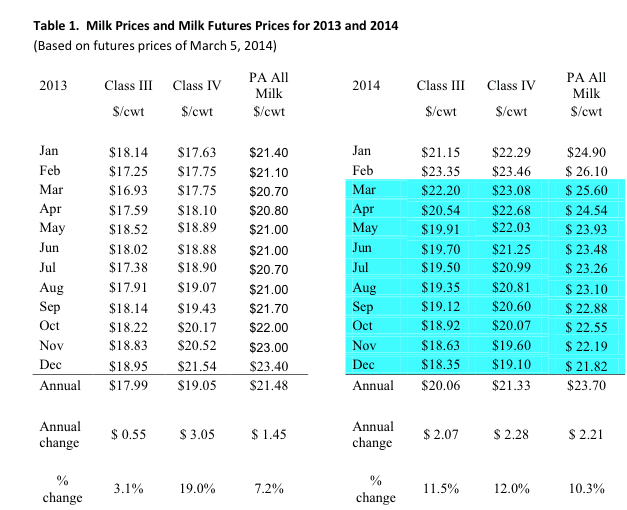
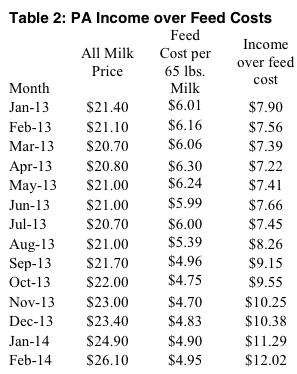
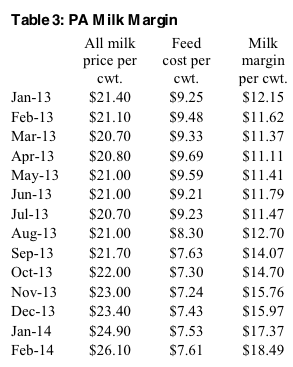
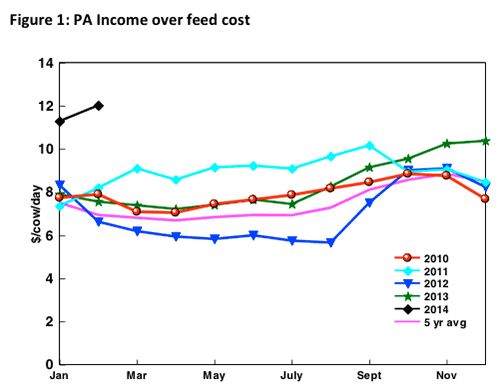
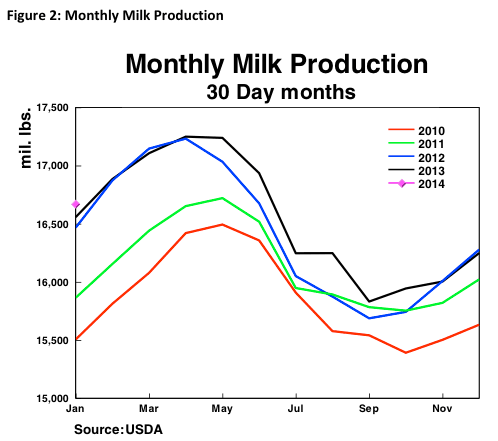
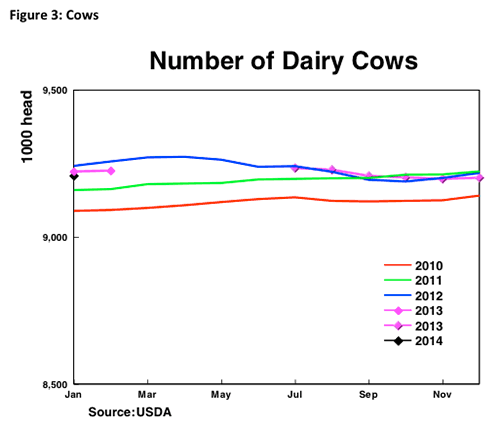
3.6.2014